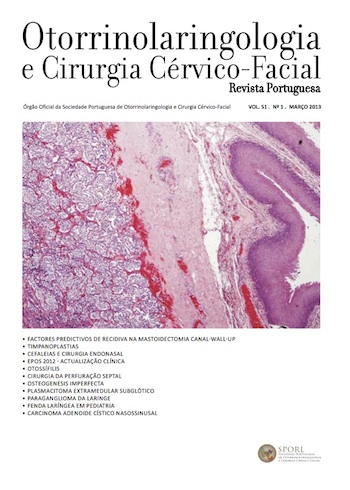Laryngeal cleft - A diagnostic and treatment challenge
DOI:
https://doi.org/10.34631/sporl.11Keywords:
esophageal atresia, laryngeal cleft, microlaryngoscopy under anesthesia, endoscopic treatmentAbstract
Laryngeal clefts are a rare, underdiagnosed, with variable severity but potentially fatal disease. We report the case of an infant submitted on his first day of life to surgical repair of long hiatus oesophageal atresia with associated tracheoesophageal fistula. At 26 days of life he began enteral feeding by mouth, presenting six days later, whilst feeding, with an episode of dessaturation and extreme bradycardia which required resuscitation. Frequent episodes of rough breathing, similar to a snort, associated with crying were noticed. Laryngotracheal bronchoscopy showed changes in the anatomy of the larynx. Microlaringoscopy under anaesthesia confirmed a laryngeal cleft extending beyond the cricoid cartilage (type III). He underwent tracheostomy and endoscopic laryngeal cleft repair at three months of life, with good outcome. In these clinical situations, a high index of suspicion is warranted as early diagnosis allows for better survival.
Downloads
References
Pezzettigotta SM, Leboulanger N, Roger G, Denoyelle F, et al. Laryngeal cleft. Otolaryngol Clin North Am. 2008;41:913-933.
Kubba H, Gibson D, Bailey M, Hartley B. Techniques and outcomes of laryngeal cleft repair: an update to the Great Ormond Street Hospital series. Ann Otol Rhinol Laryngol. 2005;114:309-313.
Benjamin B, Inglis A. Minor congenital laryngeal clefts: diagnosis and classification. Ann Otol Rhinol Laryngol. 1989;98:417-420.
Roth B, Rose KG, Benz-Bohm G, Gunther H. Laryngo-tracheooesophageal cleft. Clinical features, diagnosis and therapy. Eur J Pediatr. 1983;140:41-46.
Leboulanger N, Garabedian EN. Laryngo-tracheo-oesophageal clefts. J Rare Dis. 2011;6:81.
Watters K, Ferrari L, Rahbar R. Laryngeal cleft. Adv Otorhinolaryngol. 2012;73:95-100.
Moungthong G, Holinger LD. Laryngotracheoesophageal clefts. Ann Otol Rhinol Laryngol. 1997;106:1002-1011.
Evans KL, Courteney-Harris R, Bailey CM, Evans JN, et al. Management of posterior laryngeal and laryngotracheoesophageal clefts. Arch Otolaryngol Head Neck Surg. 1995;121:1380-1385.
Parsons DS, Herr T. Delayed diagnosis of a laryngotracheoesophageal cleft. Int J Pediatr Otorhinolaryngol. 1997;39:169-173.
Chien W, Ashland J, Haver K, Hardy SC, et al. Type 1 laryngeal cleft: establishing a functional diagnostic and management algorithm. Int J Pediatr Otorhinolaryngol. 2006;70:2073-2079.
Watters K, Ferrari L, Rahbar R. Minimally invasive approach to
laryngeal cleft. Laryngoscope. 2013;123(1):264-8
Eriksen C, Zwillenberg D, Robinson N. Diagnosis and management of cleft larynx. Literature review and case report. Ann Otol Rhinol Laryngol. 1990;99:703-708.
Condon LT, Salvage DR, Stafford ND. Type-2 submucosal posterior laryngeal cleft diagnosed on CT scan. Eur Arch Otorhinolaryngol. 2003;260:361-363.
Herman TE, Siegel MJ. Feingold syndrome: microcephaly, esophageal atresia, type III laryngeal cleft, malrotation, limb anomalies. J Perinatol. 2004;24:568-570.
Rahbar R, Chen JL, Rosen RL, Lowry KC, et al. Endoscopic repair of laryngeal cleft type I and type II: when and why? Laryngoscope. 2009;119:1797-1802.
Ahluwalia S, Pothier D, Philpott J, Sengupta P, et al. Laryngeal cleft type I: a novel method of repair using Bioplastique. J Laryngol Otol. 2004;118:648-650.
Cohen MS, Zhuang L, Simons JP, Chi DH, et al. Injection laryngoplasty for type 1 laryngeal cleft in children. Otolaryngol Head Neck Surg. 2011;144:789-793.
Nakahara S, Tayama N, Tsuchida Y. A minor laryngeal cleft (type 1-a) diagnosed in infancy. Int J Pediatr Otorhinolaryngol. 1995;32:187-191.
Kamata S, Ihara Y, Usui N, Kamiyama M, et al. Surgical management for posterior laryngeal cleft developing subglottic airway obstruction. J Pediatr Surg. 2005;40:E15-16.
Garabedian EN, Ducroz V, Roger G, Denoyelle F. Posterior laryngeal clefts: preliminary report of a new surgical procedure using tibial periosteum as an interposition graft. Laryngoscope. 1998;108:899-902.
Thiel G, Clement WA, Kubba H. The management of laryngeal clefts. Int J Pediatr Otorhinolaryngol. 2011;75:1525-1528.
Ketcham AS, Smith JE, Lee FS, Halstead LA, et al. Clinical course following endoscopic repair of type 1 laryngeal clefts. Int J Pediatr Otorhinolaryngol. 2008;72:1261-1267.






